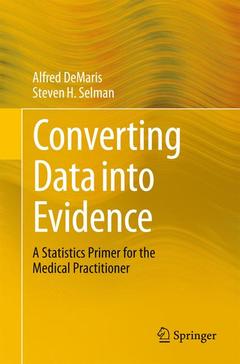Description
Converting Data into Evidence, 2013
A Statistics Primer for the Medical Practitioner
Authors: DeMaris Alfred, Selman Steven H.
Language: English
Subject for Converting Data into Evidence:
52.74 €
Subject to availability at the publisher.
Add to cartDescription
/li>Contents
/li>Biography
/li>Comment
/li>
Alfred DeMaris earned a Ph.D. in sociology from the University of Florida in 1982 and a master’s degree in statistics from Virginia Tech in 1987. He is currently professor of sociology and statistician for the Center for Family and Demographic Research at Bowling Green State University in Bowling Green, Ohio. His other statistical monographs are Logit Modeling: Practical Applications (Sage, 1992) and Regression with Social Data: Modeling Continuous and Limited Response Variables (Wiley, 2004). He has published another dozen articles and book chapters on statistical techniques as well as approximately 70 journal articles on topics in family social psychology. His work has appeared in Psychological Bulletin, Sociological Methods & Research, Social Forces, Social Psychology Quarterly, Journal of Marriage and Family, and Journal of Family Issues, among other venues. He was twice awarded the Hugo Beigel Award for the best empirical article in the Journal of Sex Research. He has been teaching statistics at the undergraduate and graduate levels for the past thirty years. Through his company, Statistical Insights, he does statistical consulting on a regular basis for individuals in the social and behavioral sciences as well as those in medicine and industry.
Steven Selman received his undergraduate degree in Engineering Physics at the University of Toledo. Following his medical school training at Case Western Reserve University he completed residencies both in General Surgery and Urology at University Hospitals of Cleveland. His research interest has principally been in the arena of urologic oncology and methodologies of urologic resident education. He has over 100 publications in the peer reviewed urologic literature. Currently, Dr. Selman serves both as residency Program Director and Chair of the Department of Urology at University of Toledo Medical Center.




